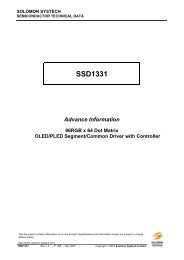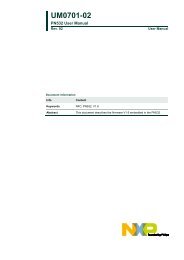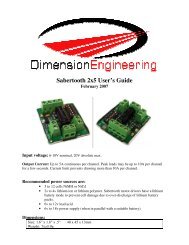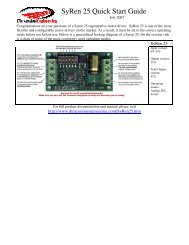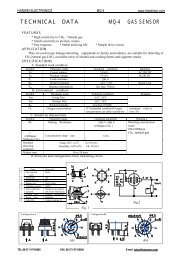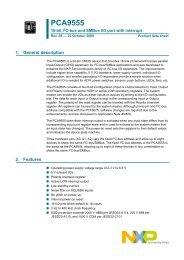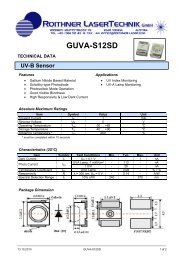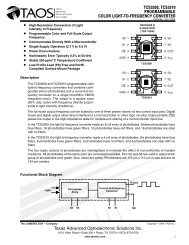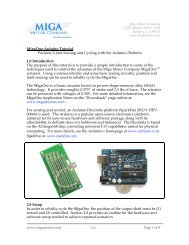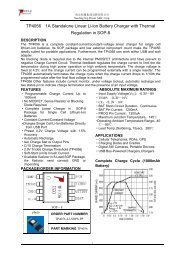3-Axis Digital Compass IC HMC5883
3-Axis Digital Compass IC HMC5883
3-Axis Digital Compass IC HMC5883
- No tags were found...
Create successful ePaper yourself
Turn your PDF publications into a flip-book with our unique Google optimized e-Paper software.
<strong>HMC5883</strong>MOUNTING CONSIDERATIONSThe following is the recommend printed circuit board (PCB) footprint for the <strong>HMC5883</strong>.PCB Pad Definition and TracesThe <strong>HMC5883</strong> is a fine pitch LCC package with a 0.50mm pin pitch (spacing), with the pin pads defined as 0.325mm by0.25mm in size. PCB pads are recommended to be oversized by 0.025mm from each pad for a short dimension oversizeof 0.05mm. The interior PCB pad is recommended to be 0.05mm oversized per pin with an exterior oversize of 0.20mmfor proper package centering and to permit test probing. Size the traces between the <strong>HMC5883</strong> and the externalcapacitors (C1 and C2) to handle the 1 ampere peak current pulses with low voltage drop on the traces.Stencil Design and Solder PasteA 4 mil stencil and 100% paste coverage is recommended for the electrical contact pads.Pick and PlacePlacement is machine dependant and no restrictions are recommended, and have been tested with mechanical centering.Placement force should be equivalent 1206 SMT resistors and enough force should be used to squeeze the paste outfrom the package/contact pad overlap and to keep the package pin contacts vertical.Reflow AssemblyThis device is classified as MSL 3 with 260 C peak reflow temperature. A baking process (125 C, 24 hrs) is required ifdevice is not kept continuously in a dry (< 10% RH) environment before assembly. No special reflow profile is required forthe <strong>HMC5883</strong> which is compatible with lead eutectic and lead-free solder paste reflow profiles. Honeywell recommendsthe adherence to solder paste manufacturer’s guidelines.INTERNAL SCHEMAT<strong>IC</strong> DIAGRAM<strong>HMC5883</strong>www.honeywell.com 5
<strong>HMC5883</strong>DUAL SUPPLY REFERENCE DESIGNSINGLE SUPPLY REFERENCE DESIGN6 www.honeywell.com
<strong>HMC5883</strong>Power on ResetPower on reset (POR) circuit shall return the device to the power-on default state. All registers shall be returned to theirdefault values. Circuitry shall return to it default state, such as, but not limited to: MUX channel, ADC state machine, andbias current.I 2 C InterfaceControl of this device is carried out via the I 2 C bus. This device will be connected to this bus as a slave device under thecontrol of a master device, such as the processor.This device shall be compliant with I 2 C-Bus Specification, document number: 9398 393 40011. As an I 2 C compatibledevice, this device has a 7-bit serial address and supports I 2 C protocols. This device shall support standard and fastmodes, 100kHz and 400kHz respectively, but cannot support the high speed mode (Hs). External pull-up resistors arerequired to support these standard and fast speed modes. Depending on the application, the internal pull-ups may beused to support slower data speeds than specified by I 2 C standards. This device does not contain 50nsec spikesuppression as required by fast mode operation in the I 2 C-Bus Specification, “Table 4 Characteristics of the SDA andSCL I/O stages for F/S-mode I 2 C-bus devices”.Activities required by the master (register read and write) have priority over internal activities, such as the measurement.The purpose of this priority is to not keep the master waiting and the I 2 C bus engaged for longer than necessary.I 2 C Pull-up ResistorsPull-up resistors are placed on the two I 2 C bus lines. Typically these resistors are off-chip, but, to conserve board spacein specific low clock speed applications, they are internal to this device.Internal ClockThe device has an internal clock for internal digital logic functions and timing management.H-Bridge for Set/Reset Strap DriveThe AS<strong>IC</strong> contains large switching FETs capable of delivering a large but brief pulse to the Set / Reset strap of thesensor. This strap is largely a resistive load.Charge Current LimitThe current that reservoir capacitor (C1) can draw when charging is limited. When using dual supplies this device shalllimit the current drawn from DVDD source to charge this capacitor. When only a single supply is used, Pin DVDD isexternally tied to pin C1. In this configuration, current is still limited. For example, the internal voltage regulator will limitthis current draw.Bias Current GeneratorThe bias current generator is used to apply a bias current to the offset strap of the magneto-resistive sensor, whichcreates an artificial magnetic field bias on the sensor. This function is enabled and the polarity is set by bits MS[n] in theconfiguration register. The bias current generator generates dc current (about 5.5mA) supplied from the AVDD supply.www.honeywell.com 9
<strong>HMC5883</strong>MODES OF OPERATIONThis device has several operating modes whose primary purpose is power management. This section describes thesemodes.Continuous-Measurement ModeDuring continuous-measurement mode, the device continuously makes measurements and places measured data in dataoutput registers. Settings in the configuration register affect the data output rate (bits DO[n]), the measurementconfiguration (bits MS[n]), and the gain (bits GN[n]) when in continuous-measurement mode. To conserve currentbetween measurements, the device is placed in a state similar to idle mode, but the mode is not changed to idle mode.That is, MD[n] bits are unchanged. Data can be re-read from the data output registers if necessary; however, if themaster does not ensure that the data register is accessed before the completion of the next measurement, the newmeasurement may be lost. All registers maintain values while in continuous-measurement mode. The I 2 C bus is enabledfor use by other devices on the network in while continuous-measurement mode.Single-Measurement ModeThis is the default single supply power-up mode. In dual supply configuration this is the default mode when AVDD goeshigh. During single-measurement mode, the device makes a single measurement and places the measured data in dataoutput registers. Settings in the configuration register affect the measurement configuration (bits MS[n]), and the gain(bits GN[n]) when in single-measurement mode. After the measurement is complete and output data registers areupdated, the device is placed sleep mode, and the mode register is changed to sleep mode by setting MD[n] bits. Allregisters maintain values while in single-measurement mode. The I 2 C bus is enabled for use by other devices on thenetwork while in single-measurement mode.Idle ModeDuring this mode the device is accessible through the I 2 C bus, but major sources of power consumption are disabled,such as, but not limited to, the ADC, the amplifier, the SVDD pin, and the sensor bias current. All registers maintainvalues while in idle mode. The I 2 C bus is enabled for use by other devices on the network while in idle mode.Sleep ModeThis is the default dual supply power-up mode when only DVDD goes high and AVDD remains low. During sleep modethe device functionality is limited to listening to the I 2 C bus. The internal clock is not running and register values are notmaintained while in sleep mode. The only functionality that exists during this mode is the device is able to recognize andexecute any instructions specific to this device but does not change from sleep mode due to other traffic on the I 2 C bus.The I 2 C bus is enabled for use by other devices on the network while in sleep mode. This mode has two practicaldifferences from idle mode. First this state will create less noise on system since the clock is disabled, and secondly thisstate is a lower current consuming state since the clock is disabled.Off ModeDuring off mode device is off. No device functionality exists. Both AVDD and DVDD are low. The I 2 C bus is enabled foruse by other devices on the network in off mode. In this mode the I 2 C pins shall be in a high impedance state.10 www.honeywell.com
<strong>HMC5883</strong>REGISTERSThis device is controlled and configured via a number of on-chip registers, which are described in this section. In thefollowing descriptions, set implies a logic 1, and reset or clear implies a logic 0, unless stated otherwise.Register ListThe table below lists the registers and their access. All address locations are 8 bits.Register AccessAddress Location Name Access00 Configuration Register A Read/Write01 Configuration Register B Read/Write02 Mode Register Read/Write03 Data Output X MSB Register Read04 Data Output X LSB Register Read05 Data Output Z MSB Register Read06 Data Output Z LSB Register Read07 Data Output Y MSB Register Read08 Data Output Y LSB Register Read09 Status Register Read10 Identification Register A Read11 Identification Register B Read12 Identification Register C ReadTable 5: Register ListThis section describes the process of reading from and writing to this device. The devices uses an address pointer toindicate which register location is to be read from or written to. These pointer locations are sent from the master to thisslave device and succeed the 7-bit address plus 1 bit read/write identifier.To minimize the communication between the master and this device, the address pointer updated automatically withoutmaster intervention. This automatic address pointer update has two additional features. First when address 12 or higheris accessed the pointer updates to address 00 and secondly when address 09 is reached, the pointer rolls back toaddress 03. Logically, the address pointer operation functions as shown below.If (address pointer = 09) then address pointer = 03Else if (address pointer >= 12) then address pointer = 0Else (address pointer) = (address pointer) + 1The address pointer value itself cannot be read via the I 2 C bus.Any attempt to read an invalid address location returns 0’s, and any write to an invalid address location or an undefined bitwithin a valid address location is ignored by this device.To move the address pointer to a random register location, first issue a “write” to that register location with no data bytefollowing the commend. For example, to move the address pointer to register 10, send 0x3C 0x0A.www.honeywell.com 11
<strong>HMC5883</strong>Configuration Register AThe configuration register is used to configure the device for setting the data output rate and measurement configuration.CRA0 through CRA7 indicate bit locations, with CRA denoting the bits that are in the configuration register. CRA7 denotesthe first bit of the data stream. The number in parenthesis indicates the default value of that bit.CRA7 CRA6 CRA5 CRA4 CRA3 CRA2 CRA1 CRA0(0) (0) (0) DO2 (1) DO1 (0) DO0 (0) MS1 (0) MS0 (0)Table 6: Configuration Register ALocation Name DescriptionCRA7 to CRA5 0 These bits must be cleared for correct operation.CRA4 to CRA2CRA1 to CRA0DO2 to DO0MS1 to MS0Data Output Rate Bits. These bits set the rate at whichdata is written to all three data output registers.Measurement Configuration Bits. These bits define themeasurement flow of the device, specifically whether ornot to incorporate an applied bias to the sensor into themeasurement.Table 7: Configuration Register A Bit DesignationsThe Table below shows all selectable output rates. All three channels shall be measured within a given output rate. Otheroutput rates with maximum rate of 116 Hz can be achieved by monitoring DRDY interrupt pin in single measurementmode. DRDY pin is normally high and is low for 5 µsec when data is placed in the output registers.DO2 DO1 DO0 Typical Data Output Rate (Hz)0 0 0 0.750 0 1 1.50 1 0 30 1 1 7.51 0 0 15 (default)1 0 1 301 1 0 751 1 1 Not usedTable 8: Data Output RatesMS1 MS0 Mode0 00 11 0Normal measurement configuration (default). In normal measurementconfiguration the device follows normal measurement flow. The positive andnegative pins of the resistive load are left floating and high impedance.Positive bias configuration for X and Y axes, negative bias configuration forZ axis. In this configuration, a positive current is forced across the resistiveload for X and Y axes, a negative current for Z axis.Negative bias configuration for X and Y axes, positive bias configuration forZ axis. In this configuration, a negative current is forced across the resistiveload for X and Y axes, a positive current for Z axis.1 1 This configuration is not used.Table 9: Measurement Modes12 www.honeywell.com
<strong>HMC5883</strong>Configuration Register BThe configuration register B for setting the device gain. CRB0 through CRB7 indicate bit locations, with CRB denoting thebits that are in the configuration register. CRB7 denotes the first bit of the data stream. The number in parenthesisindicates the default value of that bit.CRB7 CRB6 CRB5 CRB4 CRB3 CRB2 CRB1 CRB0GN2 (0) GN1 (0) GN0 (1) (0) (0) (0) (0) (0)Table 10: Configuration B RegisterLocation Name DescriptionCRB7 to CRB5GN2 to GN0Gain Configuration Bits. These bits configure the gain forthe device. The gain configuration is common for allchannels.CRB4 to CRB0 0 This bit must be cleared for correct operation.Table 11: Configuration Register B Bit DesignationsThe table below shows nominal gain settings.GN2 GN1 GN0Sensor Input FieldRange:Gain(counts/Gauss)Output Range0 0 0 ± 0.9 Ga 12800 0 1 ± 1.2 Ga 1024 (default)0 1 0 ± 1.9 Ga 7680 1 1 ± 2.5 Ga 6141 0 0 ± 4.0 Ga 4151 0 1 ± 4.6 Ga 3611 1 0 ± 5.5 Ga 3071 1 1 ± 7.9 Ga 2190xF800–0x07FF(-2048–2047 )0xF800–0x07FF(-2048–2047 )0xF800–0x07FF(-2048–2047 )0xF800–0x07FF(-2048–2047 )0xF800–0x07FF(-2048–2047 )0xF800–0x07FF(-2048–2047 )0xF800–0x07FF(-2048–2047 )0xF800–0x07FF(-2048–2047 )Table 12: Gain Settingswww.honeywell.com 13
<strong>HMC5883</strong>Mode RegisterThe mode register is an 8-bit register from which data can be read or to which data can be written. This register is used toselect the operating mode of the device. MR0 through MR7 indicate bit locations, with MR denoting the bits that are in themode register. MR7 denotes the first bit of the data stream. The number in parenthesis indicates the default value of thatbit.MR7 MR6 MR5 MR4 MR3 MR2 MR1 MR0(0) (0) (0) (0) (0) (0) MD1 (0) MD0 (1)Table 14: Mode RegisterLocation Name DescriptionMR7 toMR2MR1 toMR00 These bits must be cleared for correct operation.MD1 toMD0Mode Select Bits. These bits select the operation mode ofthis device.Table 15: Mode Register Bit DesignationsMD1 MD0 Mode0 00 1Continuous-Measurement Mode. In continuous-measurement mode,the device continuously performs measurements and places theresult in the data register. RDY goes high when new data is placedin all three registers. After a power-on or a write to the mode orconfiguration register, the first measurement set is available from allthree data output registers after a period of 2/f DO and subsequentmeasurements are available at a frequency of f DO , where f DO is thefrequency of data output.Single-Measurement Mode (default). When single-measurementmode is selected, device performs a single measurement, sets RDYhigh and returned to sleep mode. Mode register returns to sleepmode bit values. The measurement remains in the data outputregister and RDY remains high until the data output register is reador another measurement is performed.1 0 Idle Mode. Device is placed in idle mode.1 1 Sleep Mode. Device is placed in sleep mode.Table 16: Operating Modes14 www.honeywell.com
<strong>HMC5883</strong>Data Output X Registers A and BThe data output X registers are two 8-bit registers, data output register A and data output register B. These registersstore the measurement result from channel X. Data output X register A contains the MSB from the measurement result,and data output X register B contains the LSB from the measurement result. The value stored in these two registers is a16-bit value in 2’s complement form, whose range is 0xF800 to 0x07FF. DXRA0 through DXRA7 and DXRB0 throughDXRB7 indicate bit locations, with DXRA and DXRB denoting the bits that are in the data output X registers. DXRA7 andDXRB7 denote the first bit of the data stream. The number in parenthesis indicates the default value of that bit.In the event the ADC reading overflows or underflows for the given channel, or if there is a math overflow during the biasmeasurement, this data register will contain the value -4096 in 2’s complement form. This register value will clear whenafter the next valid measurement is made.DXRA7 DXRA6 DXRA5 DXRA4 DXRA3 DXRA2 DXRA1 DXRA0(0) (0) (0) (0) (0) (0) (0) (0)DXRB7 DXRB6 DXRB5 DXRB4 DXRB3 DXRB2 DXRB1 DXRB0(0) (0) (0) (0) (0) (0) (0) (0)Table 17: Data Output X Registers A and BData Output Y Registers A and BThe data output Y registers are two 8-bit registers, data output register A and data output register B. These registersstore the measurement result from channel Y. Data output Y register A contains the MSB from the measurement result,and data output Y register B contains the LSB from the measurement result. The value stored in these two registers is a16-bit value in 2’s complement form, whose range is 0xF800 to 0x07FF. DYRA0 through DYRA7 and DYRB0 throughDYRB7 indicate bit locations, with DYRA and DYRB denoting the bits that are in the data output Y registers. DYRA7 andDYRB7 denote the first bit of the data stream. The number in parenthesis indicates the default value of that bit.In the event the ADC reading overflows or underflows for the given channel, or if there is a math overflow during the biasmeasurement, this data register will contain the value -4096 in 2’s complement form. This register value will clear whenafter the next valid measurement is made.DYRA7 DYRA6 DYRA5 DYRA4 DYRA3 DYRA2 DYRA1 DYRA0(0) (0) (0) (0) (0) (0) (0) (0)DYRB7 DYRB6 DYRB5 DYRB4 DYRB3 DYRB2 DYRB1 DYRB0(0) (0) (0) (0) (0) (0) (0) (0)Table 18: Data Output Y Registers A and BData Output Z Registers A and BThe data output Z registers are two 8-bit registers, data output register A and data output register B. These registersstore the measurement result from channel Z. Data output Z register A contains the MSB from the measurement result,and data output Z register B contains the LSB from the measurement result. The value stored in these two registers is a16-bit value in 2’s complement form, whose range is 0xF800 to 0x07FF. DZRA0 through DZRA7 and DZRB0 throughDZRB7 indicate bit locations, with DZRA and DZRB denoting the bits that are in the data output Z registers. DZRA7 andDZRB7 denote the first bit of the data stream. The number in parenthesis indicates the default value of that bit.In the event the ADC reading overflows or underflows for the given channel, or if there is a math overflow during the biasmeasurement, this data register will contain the value -4096 in 2’s complement form. This register value will clear whenafter the next valid measurement is made.www.honeywell.com 15
<strong>HMC5883</strong>DZRA7 DZRA6 DZRA5 DZRA4 DZRA3 DZRA2 DZRA1 DZRA0(0) (0) (0) (0) (0) (0) (0) (0)DZRB7 DZRB6 DZRB5 DZRB4 DZRB3 DZRB2 DZRB1 DZRB0(0) (0) (0) (0) (0) (0) (0) (0)Table 19: Data Output Z Registers A and BData Output Register OperationWhen one or more of the output registers are read, new data cannot be placed in any of the output data registers until allsix data output registers are read. This requirement also impacts DRDY and RDY, which cannot be cleared until newdata is placed in all the output registers.Status RegisterThe status register is an 8-bit read-only register. This register is used to indicate device status. SR0 through SR7indicate bit locations, with SR denoting the bits that are in the status register. SR7 denotes the first bit of the data stream.SR7 SR6 SR5 SR4 SR3 SR2 SR1 SR0(0) (0) (0) (0) (0) REN (0) LOCK (0) RDY(0)Table 20: Status RegisterLocation Name DescriptionSR7 toSR30 These bits must be cleared for correct operation.SR2RENRegulator Enabled Bit. This bit is set when the internalvoltage regulator is enabled. This bit is cleared when theinternal regulator is disabled.SR1SR0LOCKRDYData output register lock. This bit is set when this some butnot all for of the six data output registers have been read.When this bit is set, the six data output registers are lockedand any new data will not be placed in these register untilon of four conditions are met: one, all six have been reador the mode changed, two, a POR is issued, three, themode is changed, or four, the measurement is changed.Ready Bit. Set when data is written to all six data registers.Cleared when device initiates a write to the data outputregisters, when in off mode, and after one or more of thedata output registers are written to. When RDY bit is clearit shall remain cleared for a minimum of 5 μs. DRDY pincan be used as an alternative to the status register formonitoring the device for measurement data.Table 21: Status Register Bit Designations16 www.honeywell.com
<strong>HMC5883</strong>Identification Register AThe identification register A is used to identify the device. IRA0 through IRA7 indicate bit locations, with IRA denoting thebits that are in the identification register A. IRA7 denotes the first bit of the data stream. The number in parenthesisindicates the default value of that bit.The identification value for this device is stored in this register. This is a read-only register.Register values. ASCII value HIRA7 IRA6 IRA5 IRA4 IRA3 IRA2 IRA1 IRA00 1 0 0 1 0 0 0Table 22: Identification Register A Default ValuesIdentification Register BThe identification register B is used to identify the device. IRB0 through IRB7 indicate bit locations, with IRB denoting thebits that are in the identification register A. IRB7 denotes the first bit of the data stream.Register values. ASCII value 4IRB7 IRB6 IRB5 IRB4 IRB3 IRB2 IRB1 IRB00 0 1 1 0 1 0 0Table 23: Identification Register B Default ValuesIdentification Register CThe identification register C is used to identify the device. IRC0 through IRC7 indicate bit locations, with IRC denoting thebits that are in the identification register A. IRC7 denotes the first bit of the data stream.Register values. ASCII value 3IRC7 IRC6 IRC5 IRC4 IRC3 IRC2 IRC1 IRC00 0 1 1 0 0 1 1Table 24: Identification Register C Default Valueswww.honeywell.com 17
<strong>HMC5883</strong>I 2 C COMMUN<strong>IC</strong>ATION PROTOCOLThe <strong>HMC5883</strong> communicates via a two-wire I2C bus system as a slave device. The <strong>HMC5883</strong> uses a simple protocolwith the interface protocol defined by the I2C bus specification, and by this document. The data rate is at the standardmode100kbps or 400kbps rates as defined in the I2C Bus Specifications. The bus bit format is an 8-bit Data/Addresssend and a 1-bit acknowledge bit. The format of the data bytes (payload) shall be case sensitive ASCII characters orbinary data to the <strong>HMC5883</strong> slave, and binary data returned. Negative binary values will be in two’s complement form.The default (factory) <strong>HMC5883</strong> 7-bit slave address is 0x3C for write operations, or 0x3D for read operations.The <strong>HMC5883</strong> Serial Clock (SCL) and Serial Data (SDA) lines have optional internal pull-up resistors, but require resistivepull-ups (Rp) between the master device (usually a host microprocessor) and the <strong>HMC5883</strong>. Pull-up resistance values ofabout 10k ohms are recommended with a nominal 1.8-volt digital supply voltage (DVDD). Other values may be used asdefined in the I2C Bus Specifications or with the internal 50k ohm pull-up resistors (SDAP, SCLP) that can be tied toDVDD.The SCL and SDA lines in this bus specification can be connected to a host of devices. The bus can be a single master tomultiple slaves, or it can be a multiple master configuration. All data transfers are initiated by the master device which isresponsible for generating the clock signal, and the data transfers are 8 bit long. All devices are addressed by I2C’sunique 7 bit address. After each 8-bit transfer, the master device generates a 9 th clock pulse, and releases the SDA line.The receiving device (addressed slave) will pull the SDA line low to acknowledge (ACK) the successful transfer or leavethe SDA high to negative acknowledge (NACK).Per the I2C spec, all transitions in the SDA line must occur when SCL is low. This requirement leads to two uniqueconditions on the bus associated with the SDA transitions when SCL is high. Master device pulling the SDA line low whilethe SCL line is high indicates the Start (S) condition, and the Stop (P) condition is when the SDA line is pulled high whilethe SCL line is high. The I2C protocol also allows for the Restart condition in which the master device issues a secondstart condition without issuing a stop.All bus transactions begin with the master device issuing the start sequence followed by the slave address byte. Theaddress byte contains the slave address; the upper 7 bits (bits7-1), and the Least Significant bit (LSb). The LSb of theaddress byte designates if the operation is a read (LSb=1) or a write (LSb=0). At the 9 th clock pulse, the receiving slavedevice will issue the ACK (or NACK). Following these bus events, the master will send data bytes for a write operation, orthe slave will clock out data with a read operation. All bus transactions are terminated with the master issuing a stopsequence.I2C bus control can be implemented with either hardware logic or in software. Typical hardware designs will release theSDA and SCL lines as appropriate to allow the slave device to manipulate these lines. In a software implementation, caremust be taken to perform these tasks in code.OPERATIONAL EXAMPLESThe <strong>HMC5883</strong> has a fairly quick stabilization time from no voltage to stable and ready for data retrieval. The nominal 8.3milli-seconds with the factory default single measurement mode means that the six bytes of magnetic data registers(DXRA, DXRB, DZRA, DZRB, DYRA, and DYRB) are filled with a valid first measurement.To change the measurement mode to continuous measurement mode, after the 8.3 milli-second power-up time send thethree bytes:0x3C 0x02 0x00This writes the 00 into the second register or mode register to switch from single to continuous measurement modesetting. With the data rate at the factory default of 15Hz updates, a 67 milli-second typical delay should be allowed by theI2C master before querying the HMC5843 data registers for new measurements. To clock out the new data, send:0x3D, and clock out DXRA, DXRB, DZRA, DZRB, DYRA, and DYRB located in registers 3 through 8. The <strong>HMC5883</strong> willautomatically re-point back to register 3 for the next 0x3D query. All six data registers must be read properly before newdata can be placed in any of these data registers.18 www.honeywell.com
<strong>HMC5883</strong>SELF TEST OPERATIONTo check the <strong>HMC5883</strong> for proper operation, a self test feature in incorporated in which the sensor offset straps areexcited to create a nominal field strength (bias field) to be measured. To implement this self test, the least significant bits(MS1 and MS0) of configuration register A are changed from 00 to 01.Then, by placing the mode register into single-measurement mode (0x01), two data acquisition cycles will be made oneach magnetic vector. The first acquisition will be a set pulse followed shortly by measurement data of the external field.The second acquisition will have the offset strap excited (about 5.5mA) in the positive bias mode for X and Y axes and thenegative bias mode for Z axis to create about a ±0.6 gauss self test field plus the external field. The first acquisition valueswill be subtracted from the second acquisition, and the net measurement will be placed into the data output registers.If the configuration register B is left at the factory default value of 0x20, values around +655 ADC counts (0.64 Ga * 1024counts/Ga) will be placed in the X and Y data output registers (around -604 in Z data output register). To leave the selftest mode, change MS1 and MS0 bit of the configuration register A back to 00. Also change the mode register if singlemeasurementmode is not the intended mode of operation.SCALE FACTOR CALIBRATIONUsing the method described above in section SELF TEST OPERATION, user can scale sensors’ sensitivity to match eachother. Since placing device in positive bias mode (or alternatively negative bias mode) applies a known artificial field onall three axes, the resulting ADC measurement in data output registers can be used to scale the sensors.Alternatively, the built-in self test can be used to periodically compensate the scaling errors due to temperature variations.A compensation factor can be found by comparing the self test outputs with the ones obtained at a known temperature.For example, if the self test output is 615 at room temperature and 630 at the current temperature then a scale factor of(615/630) should be applied to all current magnetic readings. A temperature sensor is not required using this method.EXTERNAL CAPACITORSThe two external capacitors should be ceramic type construction with low ESR characteristics. The exact ESR values arenot critical but values less than 200 milli-ohms are recommended. Reservoir capacitor C1 is nominally 4.7 µF incapacitance, with the set/reset capacitor C2 nominally 0.22 µF in capacitance. Low ESR characteristics may not be inmany small SMT ceramic capacitors (0402), so be prepared to up-size the capacitors to gain Low ESR characteristics.ORDERING INFORMATIONOrdering Number<strong>HMC5883</strong><strong>HMC5883</strong>-TRProduct3-<strong>Axis</strong> <strong>Digital</strong> <strong>Compass</strong> <strong>IC</strong>Tape and Reel 2.5k pieces/reelFIND OUT MOREFor more information on Honeywell’s Magnetic Sensors visit us online at www.honeywell.com/magneticsensors or contactus at 800-323-8295 (763-954-2474 internationally).The application circuits herein constitute typical usage and interface of Honeywell product. Honeywell does not warranty or assume liability of customerdesignedcircuits derived from this description or depiction.Honeywell reserves the right to make changes to improve reliability, function or design. Honeywell does not assume any liability arising out of theapplication or use of any product or circuit described herein; neither does it convey any license under its patent rights nor the rights of others.U.S. Patents 4,441,072, 4,533,872, 4,569,742, 4,681,812, 4,847,584 and 6,529,114 apply to the technology describedHoneywell12001 Highway 55Plymouth, MN 55441Form # 900405 Rev AMarch 2010Tel: 800-323-8295©2010 Honeywell International Inc.www.honeywell.com/magneticsensors19



